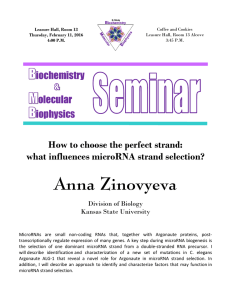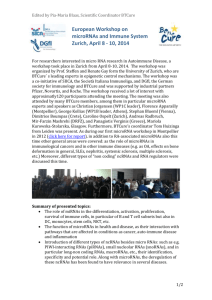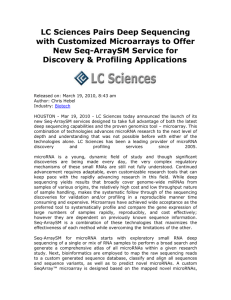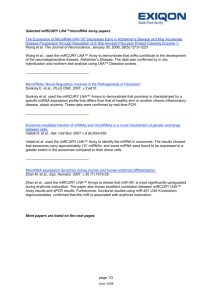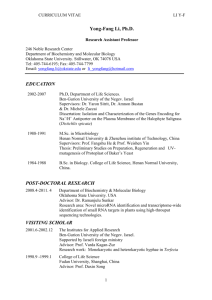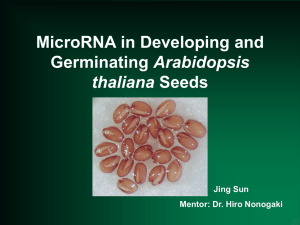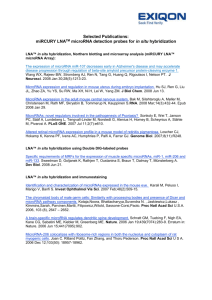AACR Poster
advertisement
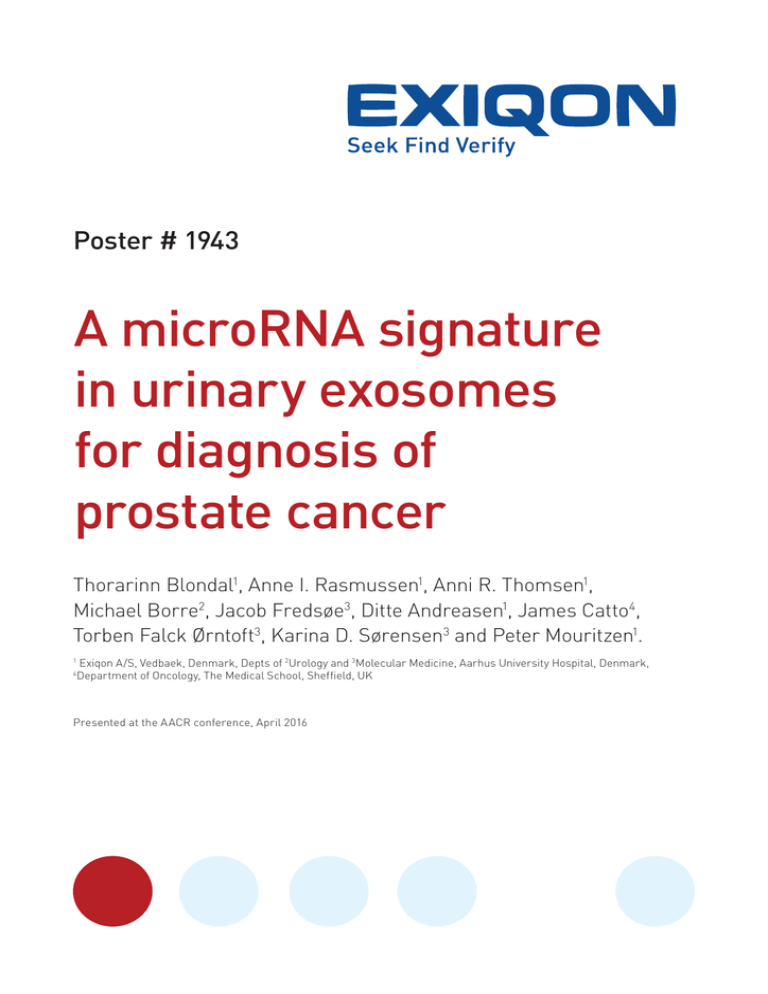
Poster # 1943 A microRNA signature in urinary exosomes for diagnosis of prostate cancer Thorarinn Blondal1, Anne I. Rasmussen1, Anni R. Thomsen1, Michael Borre2, Jacob Fredsøe3, Ditte Andreasen1, James Catto4, Torben Falck Ørntoft3, Karina D. Sørensen3 and Peter Mouritzen1. 1 4 Exiqon A/S, Vedbaek, Denmark, Depts of 2Urology and 3Molecular Medicine, Aarhus University Hospital, Denmark, Department of Oncology, The Medical School, Sheffield, UK Presented at the AACR conference, April 2016 Introduction Improved diagnostic tests for prostate cancer are needed MicroRNAs as non-invasive biomarkers • Current practice: antibody based detection of circulating prostate specific antigen (PSA) in blood • High rate of false positives and negatives • Diagnosis requires invasive FNA (Fine-Needle Aspiration) biopsies • MicroRNAs are stable in a range of biofluids • Involved in many diseases, including roles as oncogenes and tumor suppressors in cancer • Used as diagnosis, prognosis, treatment response and safety biomarkers A non-invasive test with improved specificity is urgently needed microRNAs are excellent non-invasive biomarkers for a range of diseases Exosomes stabilize and transfer microRNAs between cells Exosomes Early Endosome MVB ILV’s MVB • Exosomes are nanovesicles 40 - 140 nm in diameter • Actively released by a wide range of cell types to the extracellular milieu under normal and pathological conditions • Present in a wide range of biofluids • Carry genetic information from the cell of origin, including microRNA i Golg Lyosome Nucleus Figure 1. Urinary exosomes: new liquid biopsies for cancer • Exosomes from neoplastic cells carry potentially arrays of oncogenic molecules including proteins and microRNAs • The unique exosomal microRNA signature may reveal the cell of origin and the condition of those cells Promising non-invasive microRNA biomarkers for early detection of malignancy Challenges and Solutions for analysis of microRNAs in Biofluids Limited amount of microRNA • Optimized exosome isolation kit to enhance microRNA signals from dilute biofluid samples • Optimized RNA isolation kit for biofluids ensures high qPCR performance and reproducibility • Highly sensitive qPCR detection system MicroRNA are challenging targets • Short (19-22 nt) microRNAs accurately detected using short, highly specific LNA™ qPCR primers • Robust detection of all microRNAs regardless of GC content - enabled by LNA™ • Discrimination between highly similar microRNA family members - enabled by LNA™ Undesired components e.g. PCR Inhibitors Pre-analytical variables • RNA spike-ins to monitor RNA isolation efficiency and co-purification of inhibitors • Optimal experimental design (biological replicates) • Control sources of technical variation e.g. collection sites Figure 2. Methods Technologies to enable microRNA biomarker analysis in liquid biopsies Sample Exosome Isolation 3 ml cell-free urine miRCURY™ Exosome Isolation Kit - Cells, urine and CSF RNA Isolation miRCURY™ RNA Isolation Kit – Cell & Plant microRNA quantification miRCURY LNA™ Universal RT microRNA PCR Figure 3. Exiqon has developed technologies to fulfil these key requirements: • Methods suitable for clinical liquid biopsies (serum, plasma, urine, CSF etc.) collected using standard protocols • Exosome precipitation using a rapid method (< 1 hour), requiring only low speed centrifugation • Optimized sample preparation to minimize carryover of inhibitory compounds in biofluids • Procedures for rigorous QC of liquid biopsy samples • Highly sensitive detection system to handle the very low level of RNA found in biofluids • Highly specific detection method to discriminate between closely related microRNA family members • Detection method optimized for detection of short microRNA sequences miRCURY™ Exosome Isolation Kit Exosome isolation enables detection of more microRNAs in urine Vesicles of the correct size are recovered in the exosome pellet Exosome isolation enables a larger starting volume of biofluid to be used, increasing signals. Nanosight measurements demonstrate that vesicles of a size range compatible with exosomes are enriched from urine in the pellet. 2,5 160 2 140 Particles per ml (1010) microRNAs detected on miRNome panel I 180 120 100 80 60 40 1,5 •Pellet •Supernatant 1 0,5 20 0 0 0.2 Whole Urine 0.2 1.5 0 10 200 400 600 800 Size (nm) Exosomes Urine starting volume (ml) Figure 5. Figure 4. Rigorous QC of liquid biopsies qPCR-based QC procedures optimized for biofluids 40 35 Cq value 30 UniSp2 CP 25 UniSp4 CP 20 UniSp5 CP 15 UniSp6 CP 10 5 0 1 3 5 7 9 11 13 15 17 19 21 23 25 27 29 30 33 Urine sample number Figure 5. A range of RNA spike-ins are detected by LNA™ qPCR assays to monitor RNA isolation efficiency, inhibitors, and detect outlier samples. miRCURY LNA™ Universal RT microRNA PCR System High sensitivity and linearity - Ideal for microRNA analysis in liquid biopsies Urine/CSF • Sensitive assays are crucial, due to the low RNA content of biofluids • Exiqon’s miRCURY LNA™ microRNA PCR assays are wet-lab validated to have sensitivity and linearity over a wide range of RNA inputs, including biofluids • Red arrow indicates improvement of microRNA detection from dilute biofluid samples e.g. urine when using the miRCURY™ Exosome Isolation Kit Serum/plasma 40 FFPE 35 Tissue, Buffy coat, PAXgene and cell lines Cq values 30 25 20 15 10 2pg 20pg 200pg 2ng 20ng 200ng 2µg Total RNA input in RT reaction hsa-let-7d-5p hsa-miR-1 hsa-miR-133a hsa-miR-145-5p hsa-miR-194-5p hsa-miR-451a Figure 7. A robust system for accurate microRNA analysis - Validated on biofluids • In the largest cross-platform comparison study ever (miRQC), Exiqon’s PCR system was the only microRNA analysis platform to combine both high sensitivity and specificity (Mestdagh et al., Nature Methods 11(8):809-15, 2014) • We have used the miRCURY LNA™ Universal RT microRNA PCR System to analyze microRNAs in thousands of biofluid samples including serum, plasma and urine Step 1: First-strand synthesis (RT) Mature microRNA A) AAAAAAAAAAAAAAAAAAAA Polyadenylation B) AAAAAAAAAAAAAAAAAAAA TTTTTTTTTTTTTTT Universal Reverse Transcription: speed and convenience 5’ universal tag 3’ degenerate anchor Step 2: Real-time PCR amplification miR-specific forward primer A) LNA LNA LNA TTTTTTTTTTTTTTT LNA LNA LNA miR-specific reverse primer B) Figure 8. LNA™ in two microRNA specific primers: sensitivity and specificity SYBR Green detection: verification of amplicon Results Study overview - microRNA biomarker discovery DISCOVERY PHASE Genome wide screening Urine sample collection and analysis: Urine samples collected by hospitals in Denmark • 3 ml fresh urine (without stabilizer) was centrifuged to remove cell debris • Storage in cryotubes at -20 °C (short term) then -80 °C (long term) • Exosome and RNA isolation followed by microRNA qPCR analysis, using the methods shown in Figure 3 Urine samples collected by hospitals in the UK • Prostate massaged fresh urine (without stabilizers) was centrifuged to remove cell debris • RNA isolation without exosome isolation followed by microRNA qPCR analysis, using the method shown in Figure 3 VALIDATION PHASE Discovery screening on subset Validation set miRNA signature External validation set miRNA signature 50 individuals #1: 222 individuals (22 BPH, 200 PCa) #2: 227 individuals (22 BPH, 205 PCa) #3: 90 individuals (34 Normal, 56 PCa) In progress miRNome PCR Panels 752 microRNAs Custom PCR Panels 92 microRNAs Custom PCR Panels 92 or 48 microRNAs Custom PCR panels microRNA signature Identify subset of relevant microRNAs Identify candidate microRNA biomarkers & endogenous controls Signature identification Assess signature performance Figure 9. Genome wide microRNA profiling of cell-free urine samples: • Healthy individuals (Benign Prostatic Hyperplasia) and patients with Prostate Cancer (Stage I-IV) • A subset of relevant microRNAs were selected for subsequent discovery screening microRNA biomarker discovery and validation on cell-free urine samples: • Discovery on 222 individuals • Validation on 227 and 90 individuals from two independent retrospective cohorts • Individuals with localized or advanced localized Prostate Cancer, as well as Healthy Controls (Benign Prostatic Hyperplasia) Diagnostic microRNA signatures for prostate cancer in urine • Differentially regulated microRNAs in urine from prostate cancer individuals were identified (Cohort 1, DK) • Signatures with diagnostic potential for prostate cancer have been identified using different combinations of these microRNAs • Three-microRNA signature: high Area Under the Curve (AUC) was validated in two independent cohorts – one using sample collection and isolation protocols identical to the discovery cohort (cohort 2, DK) and one prostate massaged cell free urine without exosome isolation (cohort 3, UK) (Figure 10a) • The three microRNA signature shows high performance within the intended-use-population (cohort 2 subpopulation, DK) (Figure 10b) Cohort 2 Cohort 3 1.0 1.0 0.8 0.8 0.8 Sensitivity: 0.88 Specificity: 0.95 Cut-off: >6 0.4 0.2 0.6 Sensitivity 0.6 Sensitivity Sensitivity Cohort 1 1.0 Sensitivity: 0.78 Specificity: 0.95 Cut-off: >6 0.4 0.2 0 0.2 0.4 0.6 0.8 1.0 0.4 0 0 0.2 0.4 0.6 0.8 1.0 0 0.2 0.4 0.6 1-Specificity 1-Specificity 1-Specificity AUC = 0.955 P < 0.001 AUC = 0.892 P < 0.001 AUC = 0.794 P < 0.001 DK – no prostate massage, exosomes isolated Figure 10a. Sensitivity: 0.64 Specificity: 0.84 Cut-off: >3 0.2 0 0 0.6 0.8 UK – prostate massaged, no exosome isolation 1.0 Cohort 2 sub-population (PSA< 10 ng/mL) 1.0 Sensitivity 0.8 0.6 Sensitivity: 0.88 Specificity: 0.95 Cut-off: >6 0.4 0.2 0 0 0.2 0.4 0.6 0.8 1.0 1-Specificity AUC = 0.907 P < 0.001 DK – no prostate massage, exosomes isolated Figure 10b. A new diagnostic test (non-invasive) for prostate cancer - intended use: men with intermediary PSA levels Today’s practice – based on blood PSA – indication for Prostate Cancer: • Not specific for prostate cancer • 70 % false positives • 10-20 % false negatives • Gray-zone: PSA 3-10 ng/mL, 75 % false positives PSA < 3 ng/mL PSA 3 – 10 ng/mL (gray-zone) PSA > 10 ng/mL New test – based on urine Negative Positive microRNA signature diagnostic for Prostate Cancer: • Predict positive biopsy, 90 % accuracy • Reduce number false positives to < 10 % • Provide guidance for biopsy Active surveillance Figure 11. TRUS directed biopsy • Used for tumor grading • 47 % misdiagnosis • 30 % false negatives Conclusions • Requirements for microRNA analysis in biofluids: - RT-qPCR system with high sensitivity and specificity - Rigorous sample QC and standardization - Enrichment of exosomes is preferred in dilute biofluids • Exosome isolation enables detection of more microRNAs in dilute biofluids • The methods developed for sample preparation and LNA™-enhanced microRNA qPCR analysis have been successfully applied in cell-free urine • microRNAs in cell free urine are promising non-invasive biomarkers in prostate cancer diagnosis • A three-microRNA signature has been discovered • The three-microRNA signature has been validated in independent cohorts Acknowledgements: Nanosight data kindly provided by iNano (Dr. Ken Howard, Aarhus University). Exiqon, LNA™, and miRCURY™ are registered trademarks of Exiqon A/S, Vedbaek, Denmark. Locked Nucleic Acids (LNA™) are covered by patents and patent applications owned by Exiqon A/S. SYBR® Green is a registered trademark of Invitrogen. Concerning miRCURY LNA™ Universal RT microRNA PCR: NOTICE TO PURCHASER: LIMITED LICENSE Purchase of this product includes an immunity from suit under patents specified in the product insert to use only the amount purchased for the purchaser’s own internal research. No other patent rights are conveyed expressly, by implication, or by estoppel. Further information on purchasing licenses may be obtained by contacting the Director of Licensing, Applied Biosystems, 850 Lincoln Centre Drive, Foster City, California 94404, USA. For life science research use only. Not for use in diagnostic procedures. Outside North America Phone: +45 45 65 09 29 Fax: +45 45 66 18 88 North America Phone: +1 781 376 4150 Fax: +1 781 376 4152 Toll free (US & Canada): +1 888 miRCURY 925112 - v1.0 - 04/2016 www.exiqon.com
